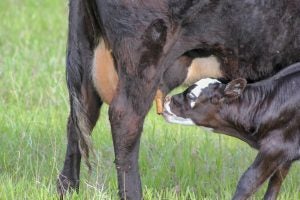Colostrum intake is of critical importance for calves — providing some 95 percent of the antibodies a calf obtains, plus a rich source of minerals, vitamins and energy — protecting newborn calves against infectious agents during the first few months of life.
“Colostrum, which is the first milk produced following birth, or a colostrum replacer if needed, can benefit overall calf health and reduce risks for calfhood diseases, increase average daily gain and more throughout a calf’s lifetime. Ensuring they receive high-quality, adequate amounts of colostrum is vital for their immediate survival and for the years to come,” said Arnold Nagely, DVM, co-founder and CEO of Valley Vet Supply.
“Getting our newborn calves off to a good start is key to long-term profits for a producer’s operation. Colostrum plays an important part in that equation,” said Troy Walz, a beef systems extension educator with Nebraska Extension who works closely alongside cow/calf producers.

A calf’s level of colostrum intake following birth can impact them throughout their life, either positively or negatively. In an American Journal of Veterinary Research study conducted at the U.S. Meat Animal Research Center in Clay Center, Nebraska, veterinary scientists sought to discover how calf health and productivity correlate with newborn calf passive immune status from colostrum. They collected blood samples 24 hours post-calving from 263 crossbred calves, determining the level of maternal immunity obtained from colostrum. From the blood sample results, newborn calves were labeled as having “inadequate” or “adequate” passive immunity status, and their health and performance were monitored from birth to weaning, and from weaning throughout the feedlot phase.
Calves with “inadequate” passive immunity experienced 5.4 times greater risk of death before weaning, 6.4 times greater risk for sickness during the first 28 days of life – resulting in an average 35-pound loss in weaning weight – and 3.2 times greater risk of sickness before weaning. For those calves marked with “inadequate” passive immunity, they experienced 3 times greater risk for health challenges in the feedlot, when compared to “adequate” calves.
Timing
Calves are born agammaglobulinemic, meaning they have almost no antibodies to protect them against disease. The calf’s intestine is only capable of absorbing colostral protection immediately following birth, up to 24 hours. Walz said that calves need about 2 quarts of colostrum (or at least 5 percent of the calf’s body weight) within four hours of birth — ideally within 30 minutes — and 1 gallon within 12 hours.
There can be many reasons a calf may not obtain the level of colostrum needed, Walz cautions. Keep a close watch, especially in these calving situations:
- Poor mothering of the dam, not letting the calf nurse
- Low-quality colostrum from the dam (heightened chances for undernourished cows and first-calving cows)
- Poor udder conformation
- Inclement weather, making calves sluggish to nurse
- Cases of dystocia
- Injuries following labor
- Quality
Maternal cow colostrum quality can vary, and if from unhealthy cows, it can contain infectious organisms, infecting the calves. “Due to the importance of colostrum, if its quality is in question, using a colostrometer can help estimate its quality,” heeds Walz. As a general rule of thumb, “A yellow color and a thick, creamy consistency are good indications of quality. Colostrum quality and quantity are usually lower in heifers. Mature cows have had more exposure to disease and will usually have a higher percentile of immunoglobulins and higher quality,” he continued.
Replacers and Supplements
“Cow/calf producers know that it is better to have colostrum and not need it, than to need it and not have it during calving season,” Nagely said.
If you are going to keep natural colostrum, “Having colostrum stored from healthy, mature cows from your own ranch can be ideal because you know those cows were exposed to the same pathogens, and they have built up immunity to those pathogens,” said Walz. “Due to the importance of colostrum to the newborn calf, it is always a good idea to have some alternative sources of colostrum on hand just in case during the calving season.”
Walz encouraged that producers be familiar with the difference in colostrum replacers, which can essentially replace a cow’s colostrum, versus colostrum supplements, which were developed to supplement the cow’s readily available colostrum, should her colostrum be lower in concentration or quantity.
“Most busy, progressive producers find that keeping a thermos of hot water and a few bags of high-quality colostrum replacer with them during the calving season is the best solution to:
- Timely colostrum administration
- Reliable immunoglobulin (IgG) content
- Freedom from infectious organisms
- Ability to immediately return the calf to its mother
- Assurance that the initial colostrum needs are met
In times when multiple calves are coming daily, this proves to be a convenient, profitable approach to success, freeing up the producer for his or her many other responsibilities of the day or night,” Nagely said.
It’s all the more important to prioritize adequate colostrum during these cold months.
“Colostrum will help young calves defend themselves from cold weather stressors like hypothermia. For the best defense against cold weather, it’s beneficial for cattlemen to have colostrum replacers and supplements, calf coats and calf warming huts available if ever needed during calving,” he said.


